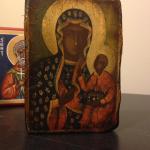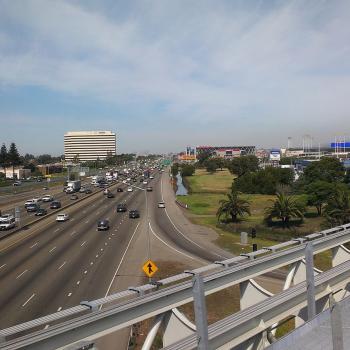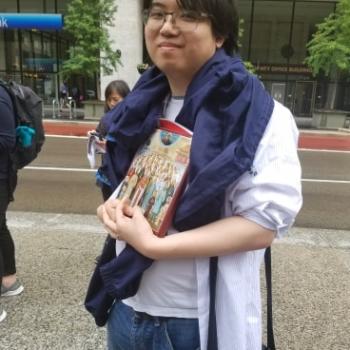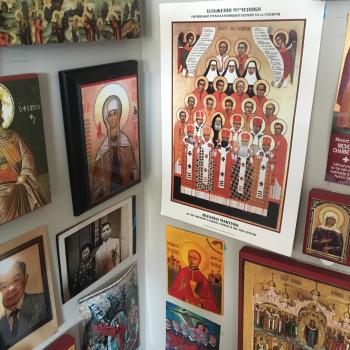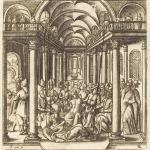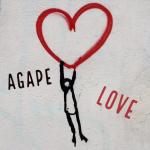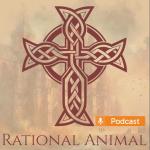![Robert Edward Lee Sculpture, Emancipation Park, Charlottesville, VA - by Cville dog, 10 January 2006 (Lee_Park,_Charlottesville,_VA.jpg) (CC BY-SA 3.0 [https://creativecommons.org/licenses/by-sa/3.0/deed.en]), via Wikimedia Commons](https://wp-media.patheos.com/blogs/sites/721/2017/08/Lee_Park_Charlottesville_VA.jpg)
The politics around the statue have been going on for some time. Although the National Association for the Advancement of Colored People (NAACP) has called for the monument to come down, what exacerbated the outcry against the figure were the same events that precipitated the rise of Black Lives Matter: the acquittal of the vigilante George Zimmerman for killing Trayvon Martin in Sanford, the protests that erupted in the wake of the police killing of Michael Brown in Ferguson, and the litany of violence against black and brown bodies whose names we have said and whose memories we continue to recite. Charlottesville city councillor Wes Bellamy declared that the statue should come down, and high school student Zyahna Bryant filed a formal petition for it to be so – ‘because it makes us feel uncomfortable and it is very offensive,’ she wrote. City council debated it, heritage activists fought to preserve it, and the case went to the courts, where it continues to be deliberated. The public park where the statue is used to be called Lee Park; now it is called Emancipation Park.
In the midst of this local drama came the motley crew of groups under Jason Kessler’s ‘Unite the Right’ banner, a kind of united front that had been molded on social media and was now manifesting in physical space, as some of them told Vice News. They had been there before; Richard Spencer, the darling of the alt-right constellation, had protested the renaming of Lee Park earlier this year, that time with torches too. In some ways, their convergence into Charlottesville, the college town in which the University of Virginia is located, fits the narrative of our day: the proximity of the statue to the school resonates with the images of clashes on college campuses over race, white supremacy, and the power of symbols, monuments, and literary canons: Mizzou, Yale, Pomona, and then the shooting at the University of Washington during the Milo event, and then Black Bloc and Antifa at Berkeley.
There was no doubt, of course, what ‘Unite the Right’ stood for. Donning polo shirts and carrying tiki torches, the crowd chanted ‘blood and soil,’ ‘white lives matter,’ and ‘you will not replace us’/’Jews will not replace us.’ Nazi flags were spotted amidst the Confederate ones; sometime comedian Christopher Cantwell was seen as a leader, as well as the Orthodox heretic Matthew Heimbach. Of course, the protest was also counter-protested; one heard, for example, the familiar college campus chant ‘No hate, no KKK, no fascist USA,’ among other ones, and by the next day, the counter-protesters had clergy link arms and walk for love, a prayer service that was threatened by the white nationalists, and a counter-protest that ended in death and the declaration of a state of emergency when a car rammed into their midst.
Protest and counter-protest: one could almost be forgiven for thinking that, like every conflict, there are ‘two sides’ – or, as in Donald Trump’s first attempt to be presidential about this, ‘many sides, many sides’ – to this story. Indeed, though Trump condemned the white nationalists and neo-Nazis in a teleprompter speech, we learned quite quickly that when the man speaks from the heart, he is quite attached to the ‘two sides’ account of this story, and with the pardoning of Joe Arpaio for his running of what was a self-proclaimed ‘concentration camp’ in which inmates in his county were held in sweltering heat in a ‘tent city’, it is not difficult to ascertain on which side he stands. On one side stands what might be called the ‘alt-right’ constellation of white nationalists, lost cause Confederates, and neo-Nazis, and the other side, as Trump put it, must be an ‘alt-left’ that is identified with violent communists under the banners of Antifa and Black Lives Matter. Just because one side is coherently organized must mean, this narrative goes, that the side demonstrating against it is also coherent.
Trump, unfortunately for the joke that he really is of a president, seemed to be taken at least somewhat seriously. Soon after the events of Charlottesville, some pointed out that if Confederate statues were symbols of oppression that should be taken down, so should figures of Lenin, especially the infamous one in the Fremont district in Seattle. Never mind that the big difference with the Fremont Lenin statue is that it is actually private property on sale instead of a public monument; there was a bit of a staged protest, and then before you knew it, Ukraine (of all places) took down all of their (public) Lenin statues, a symbol of oppression there to be sure, with its history of Russian (and to be sure, also Austro-Hungarian and Polish-Lithuanian) colonization. Back in the United States, a debate has swirled about whether the taking down of statues is even meaningful activism; it does nothing, for example, to advance material justice for poor people, especially people of color.
But here is where, I think, the significance of the General Lee monument comes back into play. The events of Charlottesville took place, it must be remembered, not because of the taking down of the statue – that was a legal and political process that of course had its own rancorous rhetoric, but stayed strictly within the bounds of civic wrangling – but because the coalition to ‘Unite the Right’ showed up to defend it. If the taking down of the statue and the renaming of the park really didn’t matter, then no one would have showed up. But they did come because it meant something to them at a visceral gut level, and what they were saying was that at least they believed that beneath all the politically correct talk about colorblind meritocracies and the marketplace of ideas and the liberal pluralistic paradise of America, white people should still be in charge – and they got confirmation that they were correct by none other than the president of the United States himself. Of course, as Steve Bannon cynically and accidentally told a reporter, these white nationalists may have all been losers that can be useful idiots to distract from opposition to a trade war with China, but in some senses, they knew themselves – and the counterprotesters who desperately contested their narrative knew it too – to be speaking a fundamental truth about how American continues to be constituted: by white supremacy.
If that is so, there are no two sides to Charlottesville. There is one side: the myth of the white supremacist establishment. However amorphous it might look, populated by revisionist idiots it might be, and internally differentiated it perhaps is, it has a coherent ideology and a coalitional organization: they were there to ‘Unite the Right.’ They spoke, if you will, the language of ‘establishment’ – not the establishment, mind you, that folks on the Left often talk about as being neoliberal and enamored with globalization and technocracy and all the other idolatries of the market that destroy local communities, but a myth that is established, foundational, ‘constitutional’ in the gut-not-document sense, primal.
There is only one thing that is required for one to be positioned against this established white supremacist myth: to oppose it. There is not much more of an ideology other than opposition, really. To take the touted example of the ‘alt-left’ popularized by Mr Trump, ‘Antifa’ is not an organization; it is a cluster of groups and individuals who generally agree that the state is on the side of capitalist corporations and because it can’t be trusted to defend ordinary people’s interests, the people themselves have to use whatever means necessary to defend themselves. ‘Black Lives Matter’ may have something of an organization, but its spread over social media makes it really more of a hashtag around which to rally for the rather uncontroversial moral claim that black (and brown) bodies, which are disproportionally targeted by state-sponsored violence, should be respected. Then there are the clergy who come from all kinds of denominational groups, many of which were considered ‘mainline Protestant,’ and then opposing Trump’s tacit support of the white nationalists was also mainstream media, corporate America, and even the military industrial complex. And then there were the ordinary people who came out to protest an ideology that they felt was wrong and unrepresentative of the pluralistic America they loved; Heather Heyer is among this group, if it can even be called a ‘group.’
The ‘counter-protest’ and its allies was not a coalition, then; it was just an outpouring of opposition, a kind of non-ideological soup against an ideology posing as primal, an outcry that included neoliberals who hate communists and communists who hate neoliberals and everyone in between and everyone else off the ideological radar too, including those who don’t know the first thing about ideology. From Boston to New York to Vancouver to San Francisco, this new street opposition, which often turns carnivalesque, has been an interesting response to attempts to ‘Unite the Right’ and participate in ‘Patriot Prayer’: there is not much holding it together, other than that people are mad and are generally against the myth of white supremacy in their own town (however much they might reinforce it through their everyday actions) and want to have a good time, to boot, especially if it means hilariously screwing up the plans of the far right. This is not really an oppositional movement; it’s just opposition, plain and simple, with a lot of people with a lot of different agendas and some with no agenda too.
Does this not recall the phenomena of yesteryear, what might be called occupy protests? Americans might be forgiven for their parochialism if they think that occupy protests only refer to Occupy Wall Street and its spinoffs, but the phenomenon, coming after the 2008 global financial meltdown and the maintenance of a global capitalist order despite it, has been global. Occupy Wall Street, after all, was inspired by Tahrir Square; Tahrir Square took its inspiration from Tunisia. The Left claims some credit for Occupy Wall Street; this is why the Maidan protests in Ukraine and the Sunflower Movement in Taiwan and the Umbrella Movement in Hong Kong are so despised. The point of these occupy protests, of course, is that there was no leader, and there were often no demands; they were often outpourings of all kinds of groups onto central squares in urban streets with all kinds of agendas and ideologies such that their saturation with ideology made them ironically non-ideological. This is, of course, the difference between neo-Nazis showing up on the Maidan and the neo-Nazis at Charlottesville; ‘Unite the Right’ was a white supremacist coalition, but Euromaidan, it must be remembered, was a pro-European Union protest that turned so ugly that everybody showed up to defend the protesters, and everybody includes both savory and unsavory characters (this is why while Ajamu Baraka’s attempt to link Charlottesville and Maidan is interesting, the comparison falls a little flat). In Hong Kong, the slogan that inaugurated the Umbrella Movement was not really I want genuine universal suffrage or Hong Kong is not China; it was protect the students when the police began firing tear gas and randomly pepper-spraying bystanders. Protect the students is not much of an ideology; it is a recipe, rather, for incoherence and disorganization. There is no ‘two sides’ to occupy protests; there is only an establishment and everybody else.
Beneath the debate about statues, then, is a conflict about what is primal. The claim of establishments, be they mythological or technocratic, is often that there is some kind of coherent narrative that underlies what it means to be belong to each other – a nation, a race, a market, a society. But the more interesting – and infinitely more difficult – idea being shown by the carnivalesque opposition to these established stories is that myths are overrated: we belong to each other simply because we live together on this same earth, and life is lived not in the stratosphere of ideology and the crystallization of identities but in the everyday practices of building homes, cooking food, falling in love, and drifting to sleep. If there is a truth to be spoken to power, it must be this personal one.
Perhaps this is why the response to the white nationalists in Charlottesville by the Governor of Virginia was so apt: Go home. You are not welcome in this great commonwealth. The key word is home; indeed, a number of counterprotesters, including Heather Heyer, had gone out into the streets to protect their hometown from a foreign ideology posing as an established myth. Maybe a home in which to live in peace is all that people want at the end of the day, and what keeps interrupting this dream are the various amorphous entities called ‘establishments.’ The paradox, we might also realize, is that to make a home, we must work together because we already co-exist beside each other; in this way, the homes we build cannot isolated zones of privacy, but sites where the commons are manifested, places where our co-existence is realized, what the Bishop of Rome calls in his encyclical letter Laudato Si’ the common home for which all people of good will care.
I write this on the ‘Feast’ of the Beheading of our Honorable and Glorious Prophet, the Forerunner and Baptist John. Tonight, I am going to my home temple in Richmond to pray a Moleben service for the new political prisoners in Hong Kong. I am sure that my thinking about Charlottesville in this vein has something to do with this, but I haven’t been able to work it out yet. Maybe this is why all blogging is the creation of works in progress.

